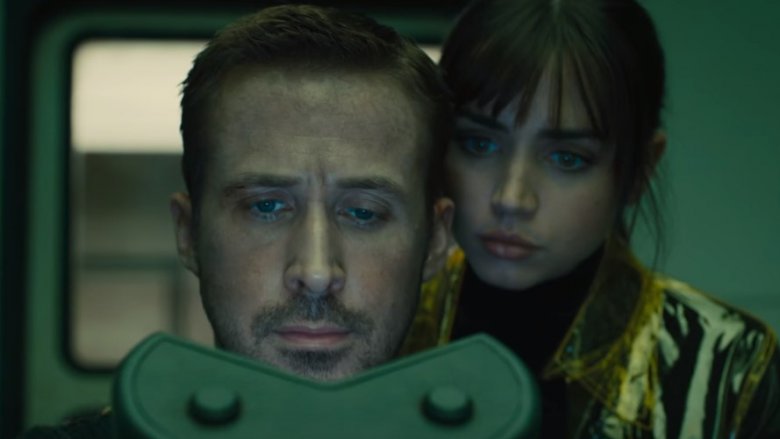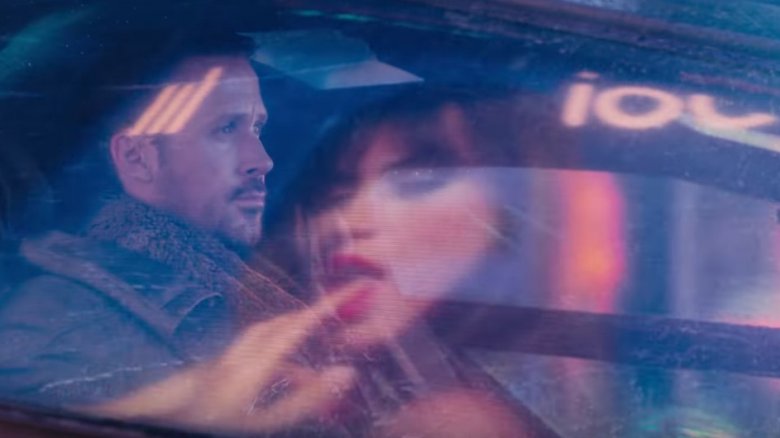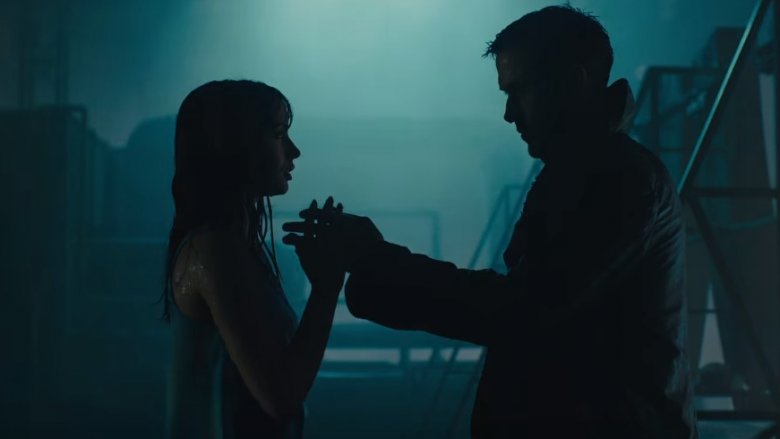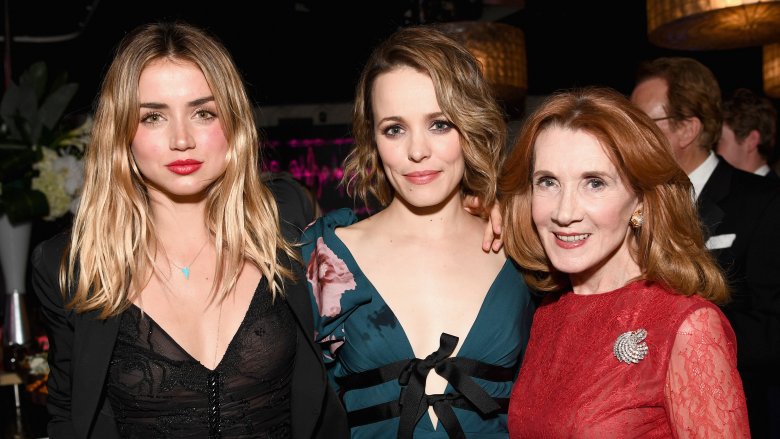Why Joi From Blade Runner 2049 Looks So Familiar
Since landing the role of Joi in the highly anticipated Blade Runner sequel Blade Runner 2049, actress Ana de Armas has shot into the spotlight—leaving many sci-fi fans wondering where they've seen her before. Since her career in English-language cinema only dates back to 2014, de Armas-spotting opportunities have been limited. Nevertheless, the actress has used the last few years to her advantage, and has quickly turned into one of Hollywood's hottest rising stars. We dug deeper into Ana de Armas' mysterious role as Joi in Blade Runner 2049 and rounded up all the young actress's past acting credits that helped her land the coveted role in this blockbuster sequel.
Before we get into the movies you may have seen her in before, let's take a look at her current role—and what Joi means in the Blade Runner universe. Major spoilers ahead.
Programmed for love
Her character may be named Joi, but de Armas' role in Blade Runner 2049 is based a little more on love than joy. In the movie, Joi is a holographic projection sold by the Wallace Corporation that basically fills the duty of...well, whatever the consumer wants. Most of the audience's interaction with Joi comes from her connection to Ryan Gosling's K, where Joi is essentially K's live-in girlfriend. She brings him dinner, lights his cigarettes, and talks to him after a hard day's work. Since K is a replicant—and pretty roundly despised by every human around him—Joi becomes his only source of personal comfort. It's a theme that becomes incredibly important as the movie progresses.
Untethered
When we're first introduced to Joi in K's apartment, her hologram can only go as far as a rail installed on the ceiling. It works if you're in, say, the living room or the kitchen, but it's pretty limiting, considering this is K's digital girlfriend. So early in the movie, K brings Joi a birthday present—a little handheld device that lets her go anywhere he goes. That device ends up playing a big part in the film's later events.
L.A. girl
With all the affection between Joi and K, don't be fooled into thinking Joi is a one-man woman. As a mass-produced product, Joi is advertised on nearly every street corner in Los Angeles, sometimes in 50-foot-tall technicolor and clad in nothing but the pixels she was born in.
Although the movie never shows any other customers with their own versions of Joi, we can safely assume that K's relationship with Joi is definitely on the tamer side of what she's capable of. When K loses Joi late in the film, those advertisements are also a visceral reminder of what he once had. When we see him, bloody and beaten, in front of a massive Joi hologram on the street, you don't need words to know what K is thinking: he could have hundreds of new Jois, but would any of them be the same?
More than code
Most importantly in a thematic sense, Joi represents K's connection to a sort of humanity. As a replicant, he isn't designed to form emotional bonds, and yet the highlight of his day seems to be coming home to Joi. That's when K gives the sense that he's happiest and most comfortable, even if those ideas are little more than artificial constructs for a robot. In this simple love story between a replicant and a computer program, you see first the seeds, and then the reality, of how much K really is able to change, despite being a so-called "fail-safe" replicant who's unable to buck the rules of his programming.
Because all that was already established, director Denis Villeneuve's intentional misdirection about K's origins later in the film made his decision to help Deckard find his daughter even more powerful. He doesn't move forward as a character because he was born special; he does it based on his own experiences. Having lost Joi himself, he's emotionally closer to Deckard's own desire to find his lost daughter.
Now that we've established Joi's place on the Blade Runner canvas, let's take a look at Ana de Armas' career leading up to Blade Runner 2049, starting with some of her more widely seen previous projects.
Knock Knock (2015)
Ana de Armas' first widely seen English-language role came in Eli Roth's erotic horror film Knock Knock, in which she terrorizes, tortures and sexually abuses Keanu Reeves' character as an underage girl—a role she very much enjoyed playing. "It was so much fun just going from little girls to pure psycho," she admitted in an interview with Screen Rant, alongside her co-star and partner in crime Lorenza Izzo. And pure psycho they went, driving Reeves to the brink of sanity.
De Armas also enjoyed making Reeves uncomfortable before the cameras started rolling. "Keanu is shy and feels uncomfortable," she recalled when describing her favorite scene from the movie. "He's not open about talking about his life in general. So we were really pushing him to the limit, playing with him and touching him and whispering things to him before the scene. He was REALLY uncomfortable. It really worked."
Poor guy!
Exposed (2016)
After ruining Keanu Reeves' life in 2015's Knock Knock, Ana de Armas again teamed up with the soft-spoken actor in Gee Malik Linton's thriller Exposed. This time, however, she didn't merely have fun making Reeves feel uncomfortable on and off camera. Instead, she learned more about the trade from the accomplished actor. "Keanu's a great partner, a great actor, a great producer in this case, and a great friend," she told TV Daily
. "It's always very easy to be with him on set; he always wants your work to be better."
Reeves also didn't hold back from heaping praise on his co-star. "When we approached Ana with the script I was like, please say yes," he recalled. "It's a great role and she's remarkable. I only have one scene with her at the end of the picture, which was great, but I wish we'd had more. In the story she's bringing such emotion, depth, comedy, warmth, love, energy and tragedy. It's such a great role and Ana is the actress for it, because she can produce all those colors and bring that to the screen."
Hands of Stone (2016)
2016 also saw Ana de Armas appear in Jonathan Jakubowicz's Cannes Festival darling Hands of Stone, a biographical sports film about Panamanian boxer Roberto Durán.
In the film, the Cuban actress plays the lover of the title's central figure—whom she didn't even know existed. "Before being involved in the project I didn't know who Roberto Durán was," she admitted in an interview with Golden Globes, "but when I read the amazing script that Jacob Jakubowicz wrote, I fell in love with the story and started investigating the family history."
In order to get inspiration for her role as Felicidad Iglesias, de Armas spent as much time as possible with the real-life people being portrayed. "In fact I went to Panama that December, I think it was 2014, to spend New Year's with them and to be with the family," she said. "From the start they opened their doors and treated us like if we were part of the family. They told us intimate stories about their lives that may not be in the film but definitely helped as a source of inspiration. I think it's important to understand what drove these people to make the life decisions they did."
War Dogs (2016)
Ana de Armas' big 2016 wrapped up with a supporting role in Todd Phillips' biographical black dramedy War Dogs, in which Jonah Hill and Miles Teller get caught up in some super shady arms dealing while exploiting a government initiative allowing small businesses to win U.S. military contracts during the Iraq War.
Though de Armas wanted to be a part of the film for multiple reasons, she mostly wanted to work with War Dogs' director. "Todd is very smart and what I find so remarkable about him is his ability to put movies together that connect so well with audiences," she remarked. "On the set, he knows what he wants and when you feel that confidence in your director, who is the person telling you what he's looking for, it's amazing. He spends time with you rehearsing, so when you hear 'Action,' you know what to do. And then you have the freedom to play around because you have the foundation of the scene."
Critics are a bit less praiseworthy of the director, however, crediting him with more misses than hits.
Overdrive (2017)
Hot off the presses is Ana de Armas' most recent pre-Blade Runner 2049 film, Overdrive—a European automobile-oriented action thriller from director Antonio Negret.
So far, Overdrive appears to be the worst big-budget film on de Armas' résumé. The car-thieving film has failed to impress and currently sits as a member of Rotten Tomatoes' 0 percent club. During its staggered release, early critics have more or less agreed that it's simply a cash-grabbing Fast and the Furious ripoff—something easily inferred from the trailer. That being said, The Hollywood Reporter praises de Armas, who "radiates more kick-ass charisma than her thankless sidekick role might suggest."
You can't win 'em all, and even a career as young as de Armas' is bound to have its ups and downs. Overdrive may not be a feature she's quick to point to when discussing her career in later years—but given how many high-profile features she's already landed, she probably won't have to. Blade Runner 2049 looks like the beginning of a beautiful blockbuster career.
She learned how to act in Cuba
Now that we've explored some of Ana de Armas' most widely seen work, let's take a closer look at how exactly she went from a teen actress in Cuba to one of Hollywood's hottest rising stars.
Born and raised in Cuba, de Armas studied at the country's National School of Arts. It was there that Spanish director and screenwriter Manuel Gutiérrez Aragón discovered the 16-year-old, selecting the teen for her very first role in Una rosa de Francia.
"I am in debt to Una rosa de Francia, Manuel Gutiérrez Aragón, Jorge Perugorría, Tamara Morales, and everyone involved in that project," she told OnCuba
, "for being able to discover so freely and so passionately what it means to act in [a] film. That movie taught me all the rules of a film shoot: discipline, study, late nights, respect for all team members, and above all, to realize how lucky we are to do what we love and make a living from it."
Landing a big-time gig in a Spanish film as a teenager in Cuba truly changed de Armas' life. "When you experience that at the age of 16," she explained, "it can scare you or it can fill you with courage and hunger for more. And I wanted to eat up the world. Moreover, it really opened the door for me to the Spanish market, which later took me in and gave me work for many years."
She snuck out of school to film
Before Ana de Armas made big waves in the Spanish market, however, she had the opportunity to work with one of Cuba's most legendary film directors, Fernando Pérez, in his film Madrigal. "[Madrigal] was my second experience in film," de Armas told OnCuba
. "It was a brief experience, and I had a small part, but I gave it my best and I really enjoyed myself."
Though the role was minor, working with Pérez was a crucial step in de Armas' development as an actress. "Fernando Pérez is one of the best people I've ever known," she explained. "He is a man with an enormous heart, and that is always reflected in his films. I still remember the day I auditioned as if it were today. Fernando whispered something to me, I think to explain the scene; I'm honestly not sure, because what stayed with me was the tone of his voice, sweet and melancholic. His voice was my motivation."
Motivation has remained a theme throughout de Armas' life. As a teenage art student just starting out in the film industry, she was up to the challenge of juggling school and work—even if it wasn't allowed. "That time, I didn't have permission to film from drama school, so I had to sneak out a bunch of times to film at night, and then the next day I would fall asleep in class. It was worth it!"
She moved to Spain at 18...
Though she ardently studied acting, Ana de Armas never actually finished her drama school education. Instead, she decided to take advantage of her dual passport by moving to Spain, albeit with only 200 euros in her pocket. "I went to Spain when I finished drama school," she told OnCuba
. "Well, technically I didn't finish school; I had to leave before I presented my final thesis. I was 18 years old and I felt like the time was right to move on. My parents supported me in everything, they always have."
Her life-changing decision to move across the Atlantic Ocean was made purely on instinct—a trend de Armas has successfully followed throughout her young career. "I don't remember having thought it over much," she explained, "partly because I didn't know what it meant to live and survive in another country, and partly because I almost never question my instinct. I went with 200 euros in my pocket that I'd saved from the last film that I made in Cuba, El edén perdido, and I told my parents that I'd be back when my money ran out."
As one might expect, 200 euros didn't last long. "My money ran out in a week," de Armas admitted, "[but] I didn't go back." And good thing—she met the casting director for El Internado after only two weeks in Madrid, which would mark the moment that truly launched her career.
...But she's proud to be Cuban
Despite never moving back to the country of her birth and holding a dual passport, Ana de Armas is proud of her Cuban heritage. "You simply can't deny what you are," she argued. "Having been born in Cuba is part of my identity, not a label. I've always been proud of having been born and raised there, because of the personal importance it has for me, the emotional connection, because I respect my roots and my parents. Because my good and bad experiences shaped me and made me into who I am today."
However, de Armas isn't proud to be Cuban in some purely nationalistic way. Rather, she's proud to identify with her history, family, and friends. "I would be just as proud to have been born in another country," she explained, "if I had the same parents and friends that I have in Cuba, the ones I grew up with. That is what Cuba means to me; Cuba is my home because it's where my people are."
As a proud Cuban, she'd also like to contribute to her country's film history... but that's not as easy as it might seem. In Cuba, "the figure of agent or representative doesn't exist," she explained, "[and] I think that Cuban directors and producers assume that they will get 'no' for an answer, and they don't even try to make the approach. It's a shame ... Without a doubt, I'd like to be part of Cuban film history."
Spanish-language movies and TV (2006-2014)
Before Ana de Armas burst into the global mainstream by landing herself the role of Joi in Blade Runner 2049, the Cuban actress was a star of Spanish-language cinema and TV. If you'd like to test your Spanish comprehension, you can check her out as Marie in Una rosa de Francia, Stella Maris in Madrigal, Carola in Mentiras y gordas, Rosa in El callejón, and Sol in Por un puñado de besos. Perhaps more notably, she starred as Carolina Leal Solís in the extremely popular Spanish television series El internado, as well as playing Nerea in Hispania, la leyenda. Her last big-time Spanish project came in the form of Antonio Trashorras' freaky film Anabel—which does artistic horror in ways only Spanish cinema can.
After gaining traction in Spanish-language series and movies, de Armas made the transition into English-language cinema. In order to do that, however, she first had to learn English...and fast. In fact, she told AOL Build that she didn't speak any English when she moved to Los Angeles in 2014—remarkable, given the cinematic track record that would immediately follow.
Moving to Hollywood wasn't easy
After making a name for herself in Spain, Ana de Armas trusted her gut again and moved to Hollywood. "I moved to Los Angeles because my instinct told me it was time to move, to test myself, to dream bigger," she explained. "I wasn't completely convinced that I was ready for the challenge, but I thought that if I kept mulling it over, it would never seem like the right time, so I went. For me, starting over is a good thing; it's another opportunity; it's learning; it's demonstrating to myself that I'm strong and I can do anything. It's the ambition of wanting to be a better person and artist, and I'm not afraid of that."
Of course, moving to the nexus of the entertainment industry wasn't easy. "Moving to L.A. was hard," de Armas told Vanity Fair. "I had a career in Spain, and you have to forget your ego. I was a nobody again." Furthermore, she explained to OnCuba that "the industry is gigantic and there's an equal probability that they won't see you and that they'll step all over you. Los Angeles can be a very lonely city, but if you have clear ideas and work hard, big opportunities can open up for you ... For now, it seems like everything's going well, although you never know; nothing's for sure."
Maybe... but so far, we'd say de Armas' future success if a safe bet.
She won't let her accent limit her roles
When Ana de Armas made the move from Madrid to Hollywood, she didn't speak any English... but she refused to let that stop her from landing English-language roles in no time at all. Still, the actress speaks English with a strong Cuban accent. And while an accent can sometimes work in an actress' benefit, she won't let her distinct accent pigeonhole her into "sexy Latina" roles.
"When I went to Spain and began working on El Internado, I had the great fortune that all of the series' producers were in agreement with my accent," she explained to OnCuba
. "Now with English, it's a different story; it's not just the accent—it's the language. So in this case, I am working on it. I don't want to limit myself to Latina characters, I want to have a much broader range."
As has been the case with almost everything in her career, de Armas looks at the language barrier as an opportunity to grow as an actress: "It will take time, but I'm not experiencing that as something negative; on the contrary, I view it as if I were learning how to use a new superpower. If I've come to the place where there's access to the best projects in the world, it's not going to be my accent that stops me."
She's been all over the newsstand
Even if you haven't seen Ana de Armas on the big screen, there's a pretty good chance you've seen her on a magazine rack.
The actress has modeled for various outlets since 2007, though her first major spread came in the April 2008's Spanish-language FHM. With the uber-popular Spanish TV series El Internado skyrocketing de Armas into the spotlight, she also made appearances in Super Pop, OK, Bravo, 40 Magazine, Promesas de Buen Cine, Dominical, Larios Calendar, MUST, Glamour, and Pantalla. Subsequent years saw her appear in both Spanish and English-language heavy hitters, including W Magazine, Instyle, GQ, Vanity Fair and Elle. Most recently, de Armas can be found in issues of Glamour, GQ UK, Entertainment Weekly, Vogue, Esquire, and Marie Claire. Clearly, magazines can't get enough of her, and it's easy to see why.
If the latest issue of your magazine of choice doesn't have de Armas in it, you can always follow her on Instagram, where she posts her latest kickboxing videos, fashion shots, press-day makeup routines and clips of her dancing with her Blade Runner 2049 co-stars.
She isn't letting fame go to her head
In addition to her willingness to take risks and accept career obstacles as positive challenges, de Armas' success can also be attributed to her mature stance on fame. "Fame and success are never a constant," she explained to OnCuba
, "just like the people who want to be around you or disappear according to their convenience. I've always been very clear on that, and I've always given it the right amount of importance."
Growing up in Cuba has helped de Armas stay grounded. "I think that the early years of my career were the ones with the most change," she said, "and the most critical in terms of the impact of fame on my personal life. But the fact that I always stayed connected with my parents and friends and the many visits I've made to Cuba have kept me close to reality. My family is what makes me think every day about what's really important in my life."
Still, as de Armas has recently learned, there's no escaping being a celebrity: "My life hasn't changed much, although at times it is hard to ignore it when people look at you or follow you in the street; I try to stick to my routine and to my world. Now in the United States ... I'm invisible again ... I imagine it won't stay that way forever. When things change, we'll see what happens, but now I know what to expect, so there's no way it will be too much for me."








